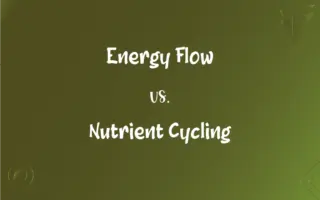Rooster vs. Hen: What's the Difference?
Edited by Janet White || By Harlon Moss || Updated on June 10, 2024
A rooster is a male chicken; a hen is a female chicken.

Key Differences
A rooster, known for its colorful plumage and crowing, is the male counterpart of the domesticated chicken species. In contrast, a hen, often more subdued in color, is the female of the species and is primarily associated with laying eggs.
Roosters often have brighter and more varied colors, showcasing long flowing tails and hackles, while hens generally exhibit muted tones and lack the elaborate tail feathers that roosters possess.
Behaviorally, roosters are more aggressive and territorial, often seen guarding flocks. Hens, on the other hand, display maternal behaviors and can be observed brooding over their eggs or nurturing chicks.
It's essential to recognize that roosters, due to their crowing, are often unwelcome in urban settings because of noise concerns. Hens, conversely, are prized in many suburban backyards for their egg-laying abilities.
When it comes to the culinary world, roosters, often referred to as cocks, may be used in specific dishes or broths, whereas hens are commonly used for their meat and, of course, their eggs.
ADVERTISEMENT
Comparison Chart
Gender
Male
Female
Appearance
Bright, varied colors, long tails
Muted tones, shorter tail feathers
Behavior
Aggressive, territorial
Maternal, nurturing
Primary Association
Crowing, guarding flocks
Egg-laying, brooding
Culinary Usage
Specific dishes, broths
Meat and eggs
ADVERTISEMENT
Rooster and Hen Definitions
Rooster
Known for its vibrant and varied plumage.
The rooster's bright feathers caught everyone's attention.
Hen
Known primarily for laying eggs.
The farmer counted the eggs each hen produced daily.
Rooster
Associated with the iconic crowing sound.
We were awakened by the rooster's crow every morning.
Hen
A female domesticated chicken.
The hen diligently sat on her nest of eggs.
Rooster
Often used in specific culinary preparations.
The chef used a rooster to prepare the traditional broth.
Hen
Generally has muted colored feathers.
The brown hen blended in well with the earthy background.
Rooster
A male domesticated chicken.
The rooster crowed loudly at dawn.
Hen
Commonly used for meat and egg production.
The soup was made using a young hen for added flavor.
Rooster
The protective male of the chicken flock.
The rooster aggressively defended the chicks from predators.
Hen
Displays maternal behaviors, especially with chicks.
The hen clucked softly, guiding her chicks to food.
Rooster
An adult male chicken.
Hen
A female bird, especially the adult female chicken.
Rooster
An adult male of certain other birds.
Hen
The female of certain aquatic animals, such as an octopus or lobster.
FAQs
Which one crows, the rooster or the hen?
The rooster is known for its crowing.
Can you determine a chicken's gender by its color?
While roosters often have brighter plumage, color alone isn't a definitive gender indicator.
What is the primary distinction between a rooster and a hen?
A rooster is male, and a hen is female.
Are hens or roosters typically used for egg production?
Hens are used for egg production as they lay eggs.
Can both roosters and hens be kept together in a flock?
Yes, but care should be taken to manage aggression and breeding.
Is a rooster required to hatch chicks?
Only if you want fertilized eggs that can develop into chicks.
Do all roosters crow?
While most do, the frequency and volume can vary among individual roosters.
Can you eat both rooster and hen eggs?
Generally, people eat hen eggs; rooster eggs refer to fertilized eggs, which can be consumed but are less common.
Do hens need roosters to be happy and healthy?
No, hens can thrive without roosters.
Are roosters more colorful than hens?
Generally, roosters have brighter and more varied plumage than hens.
Why might someone prefer to keep a rooster with hens?
A rooster can protect hens and fertilize eggs.
Are roosters necessary for hens to lay eggs?
No, hens can lay eggs without roosters, but those eggs won't be fertilized.
Which has a louder call, a rooster or a hen?
Roosters, with their crowing, are generally louder than hens.
Which is larger, a rooster or a hen?
Typically, roosters are larger and more robust than hens.
Which tends to be more aggressive, roosters or hens?
Roosters are typically more aggressive and territorial.
Why are roosters often not allowed in urban areas?
Due to their loud crowing, roosters can be a noise concern in urban settings.
Which is more maternal, a rooster or a hen?
Hens display more maternal behaviors, especially towards chicks.
Which tends to live longer, a rooster or a hen?
Lifespan varies, but typically, under similar conditions, both can have comparable lifespans.
Why do hens cluck?
Clucking is a way hens communicate, especially with their chicks or to express various emotions and states.
Is the meat of a rooster different from that of a hen?
Yes, rooster meat can be tougher and more flavorful, while hen meat is often tender.
About Author
Written by
Harlon MossHarlon is a seasoned quality moderator and accomplished content writer for Difference Wiki. An alumnus of the prestigious University of California, he earned his degree in Computer Science. Leveraging his academic background, Harlon brings a meticulous and informed perspective to his work, ensuring content accuracy and excellence.
Edited by
Janet WhiteJanet White has been an esteemed writer and blogger for Difference Wiki. Holding a Master's degree in Science and Medical Journalism from the prestigious Boston University, she has consistently demonstrated her expertise and passion for her field. When she's not immersed in her work, Janet relishes her time exercising, delving into a good book, and cherishing moments with friends and family.































































